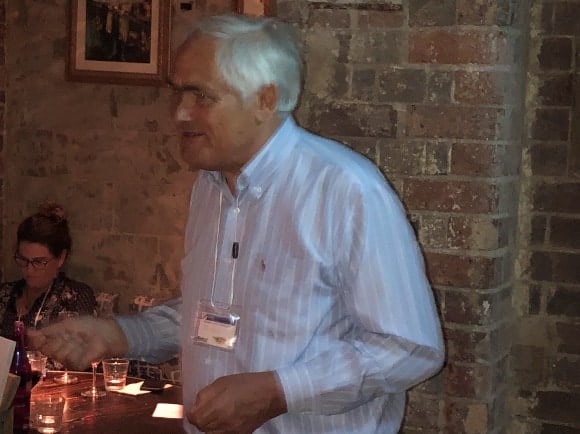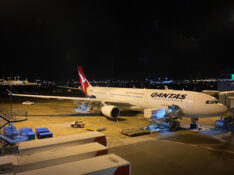The History of Airport Slots – Ernst Krolke Speech at AFF#13

Ever wondered how congested airports manage the flow of traffic throughout the day to ensure all flights don’t arrive and depart at exactly the same time? It’s all managed through “slots”.
Ernst Krolke, who was recently inducted into the Australian Aviation Hall of Fame, ran Airport Coordination Australia for 20 years and was instrumental in developing the airport slot system we have in Australia today. Ernst was a guest speaker at the recent AFF#13 gathering in Sydney, where he spoke about this.
For those who couldn’t make the event, here is a transcript of Ernst’s speech on 19 October 2019.
I remember as a schoolboy, going to the airport, collecting timetables from the airlines, and I started reading the timetables like other people read books. And then I said, “I can do that!”
So in 1954, I started an airline on paper. That airline still exists today. It’s no longer on paper – it’s on computer of course. But that brought me very much in contact with KLM in Germany and with British European Airways. In 1956, I started working for KLM in the normal office doing cargo, doing passengers, doing everything like that.
In 1960 Qantas came along and said, “Would you like to join us in Frankfurt as our sales promotion officer for northern Europe?” What I had to do, as my number one task, was to produce local language timetables with connections from the various places to the Qantas flights. So I produced timetables in 17 different languages.
The person that I was, I constantly criticised people in head office about the bad schedules we had into Europe and how the schedules could be improved. So, what did Qantas do? They came in 1965 when I was in London and said, “You’re wasted in Europe. We want in in Sydney! We want in you planning! Are you going to come?” And I said, “Yes please!”. That was the best thing I ever did.
So I joined in January 1966 Qantas’ planning and scheduling department. In ’77 I became the manager of fleet planning and scheduling, and held that position up to 1998 (with a number of title changes).
I brought the Qantas schedule under control, made purchases of aircraft to a certain degree, and over this time a new thing started to develop – and that’s what I want to talk about today – which is called “slots”.
In about 1960 we got new aircraft. We had the 707 and the DC8, and these aircraft were bigger than previous aircraft with twice as many passengers on board. So, all the facilities and the airports became too small. The apron, the check-in, the baggage areas, and the airports started pushing back and saying, “We don’t want more flights at that time or this time”. What the airlines had to start to do was organise their schedules around the capacity limitations.
Of course, with the successful introduction of the 707 and DC8, more and more flights started to fly, flying became cheaper, and then we got the 747 and the DC10 around 1970. By that time, things became very, very bad. The airlines under IATA used to have twice a year a meeting to coordinate their timetables. Because in the old days, when they were flying DC6’s and DC7’s, they didn’t fly all daily flights and they didn’t want to risk connections. So that was purely a marketing exercise.
By the 70’s that turned totally around. It became important that you had an arrival and departure time planned at the airport, which we called a slot. A slot is nothing more than a permission for an airline to arrive or depart at a time at an airport. And how many slots were available depended on whatever criteria had to be used to allocate those slots. The whole system worldwide was done very much on a voluntary basis. In IATA in 1974, we published the first “scheduling procedures guide”. There were around 10 pages on what instructions had to be followed in the allocation of a slot.
One of the most important elements that got introduced at that time was the historic precedence of grandfather rights. That was the only thing that put sanity in the whole system. What that means is, for example, if you have a Monday slot to fly from Sydney to Melbourne in April-October this year, and you’ve flown it 80% of the time, you have the right to operate that flight next year. That means an airline can buy an aircraft, because they know that if they operate properly and to the proper times, nobody will take their slots away. (Unless the market collapses.)
What does it mean to the airports? Well if an airline flies regularly, it gives the airport a regular income. And what does it mean to the passengers? If the airline operates the flight regularly, they can rely on it and they can plan their business travel accordingly. So, the historic precedence is very important. It sometimes gets criticised, particularly by low-cost airlines that come new in the market. And universities who put out perfect schemes that could replace the slot system – but all of them would be unworkable.
The most unworkable example I can give you was, in 1988, when the Air Traffic Control in the US went on strike. There was no ATC, the military did a little bit, and the FAA allocated slots to the airlines. My colleague from TWA said to me, “How can I schedule a flight from New York to San Francisco if my departure time from New York is 8 o’clock and my arrival time is 3 o’clock in the afternoon… and the distance is 3 and a half hours on the clock?”
In the 70’s, basically, the national carriers in each country took over the coordination of the airports in their country. Qantas took on the coordination of the international terminals only in the Australian market.
Worldwide, the guidelines still live today. They have been amended and the book is now 40 pages long because more things have happened, we have certain regards for new entrant airlines, and so on. But the only area that put the guidelines from a voluntary system into a government-allocated system were the Europeans. In 1992, they created the European code of conduct for slot allocation. That was the first time it was enshrined into the law.
So now, what happens in Australia? As I said, international services were coordinated by Qantas – that was done in my office and the FAC was very happy with the way it was done and said, “If you ever leave, Qantas can no longer coordinate”. And I said, “I’m not going to leave”.
But in 1996, the Australian government out of the blue declared a limit of 80 aircraft movements per hour for Sydney Airport for environmental reasons. The number 80 was arbitrary. Fortunately, in about 1993 I had written a paper saying it’s inevitable that Australia will have to be coordinated at some stage and this is what needs to be done. So I took that paper out, gave it to Qantas, and said “That’s what needs to be done”.
Qantas gave it to the government in Canberra, and Canberra then set up a small working group which included the government agencies, myself and John Benson from Ansett, who was a very well-established scheduler in Ansett. John and I had to make sure that the regulation that had to be created was manageable. We did that, and it became the 1997 Sydney Airport Demand Management Act.
The next step was that we needed a company to run it because it had to be done independently. Qantas couldn’t do it anymore. So I went to Qantas and said, “I’m happy to take early retirement and I’ll run the company”. Qantas and Ansett both said, “That sounds like a good idea.” But the government said, “We’re not so sure about it. Let’s ask all the Australian airlines that operate into Sydney.” There were about 11 of them. Some of them were country connections that had a little Piper with 9 seats flying around. And they all wanted me to do it.
For me, on one side it was pretty good. But on the other side it gave me a lot of responsibility because the domestic airlines had no idea about coordination. They were always flying whatever they wanted to do. Now they had to come to someone and ask, “Am I allowed to change that slot?” or “Is that slot available for me to do this?”. Totally different work environment.
But I managed, and nobody complained. At a later meeting at Sydney Airport I ran into James Strong and said, “I think we have done pretty well. We have established two new low-cost airlines in Australia; Virgin Blue and Impulse. And we have not confiscated one single slot from you. We just used the slots efficiently.” He agreed with me, whether he wanted to or not. But it worked.
I then ran Airport Coordination Australia (ACA) for the last 20 years. The [Sydney Airport cap of] 80 movements per hour really means that we can operate 1,360 flights in a day. But in reality, we never have more than about 1,000 flights in a day. People complain there are no slots available, yet around 75% of the slots get used. The other slots are “unusable”. In the middle of the day nobody wants to fly, and late at night nobody wants to fly. And then we have the curfew in Sydney. So we only have 17 operating hours.
Every flight that you go through has a slot allocated at an airport. That all happens in the background. The IATA meetings have been turned into slot conferences. They take place twice a year. We have there about 350 airlines attending with 80 coordinators, coordinating some 280 congested airports in the world in 3 working days. A lot of work is done beforehand. And this conference is attended by about 1,300 people. The airline people are running around all day from coordinator to coordinator getting their slots organised. And why is it done this way? Because if you can’t get a matching slot at an airport that you need, you can go and talk to the coordinator. The coordinator can tell you what’s available. If you can’t take any other options, they can tell you what other airlines have and you can go and talk to the other airline. 97% of problems get solved in this way. It’s a great system, it works well and the next conference is in November in Brisbane.
I have heard that you tomorrow are going down south on an excursion to the Historic Aircraft Restoration Society (HARS). Fantastic place. In that place, on mezzanine floor, is the Australian Aviation Hall of Fame. You can see all the people in there that have been inducted in the Hall of Fame. I was lucky enough to have been inducted at the end of last year and the reason is the work that I have done to introduce slot management in Australia.


